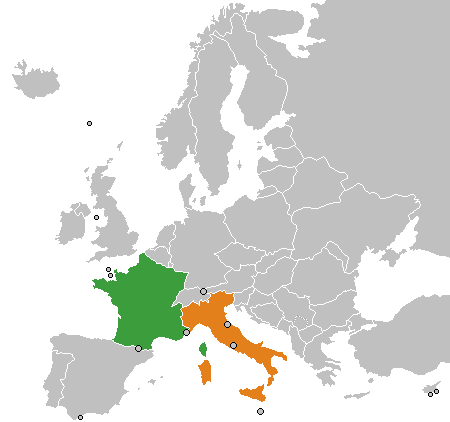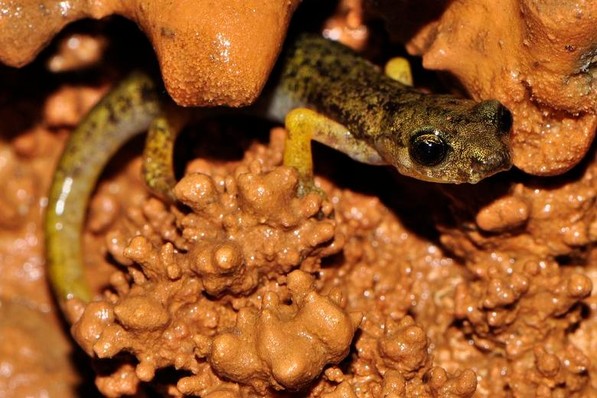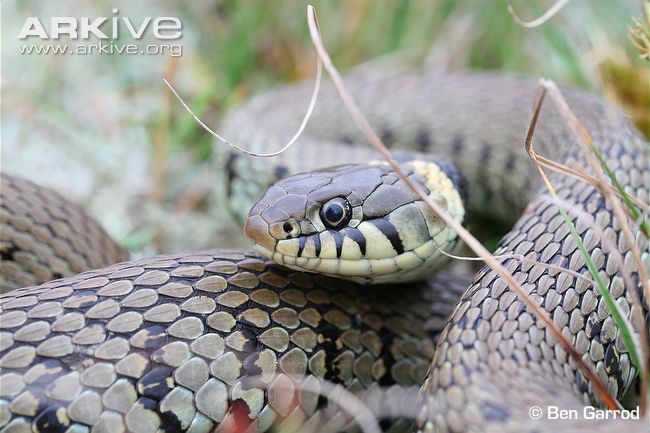Where in the world can you find Speleomantes strinatii?
 Speleomantes strinatii is native to northwest Italy and
southeastern France (INCN Red List
of Threatened Species 2009). There is evidence of
exact locations of this species in the Maritime Alps in France as
well as in Monte Pietravechia, W. Monte Groppi, Rio Tonno, San
Bartolomeo, and Trabocchetto in Italy (Carranza et al. 2007).
Speleomantes strinatii is native to northwest Italy and
southeastern France (INCN Red List
of Threatened Species 2009). There is evidence of
exact locations of this species in the Maritime Alps in France as
well as in Monte Pietravechia, W. Monte Groppi, Rio Tonno, San
Bartolomeo, and Trabocchetto in Italy (Carranza et al. 2007).
This photo, from
Wikimedia Commons,
highlights where France and Italy are located.
Where does close relatives of North-west Italian Cave Salamanders live?
There are seven European Hydromantes that are closely related to
the American Hydromantes which are found in California (Carranza et al.
2007). Two species that are located in California and related to
the European Hydromantes are Hydromantes brunis and Hydromantes
platycepalus (Carranza et al. 2007). European Hydromantes live in
similar habitats as the Californian Hydromantes; therefore, the
separation between the Hydromantes did not result in a huge
variation (Carranza et al. 2007). European and American Hydromantes
were separated approximately 13.5 Ma (Carranza et al. 2007). Before
this evidence, it was believed that the separation of European and
American Hydromantes occurred earlier (Carranza et al. 2007). It
also is believed that the migration occurred across the Bering Land
Bridge, which exists between Alaska and Siberia (Carranza et al.
2007). The genus of European cave salamanders is more recently
known as Speleomantes; therefore, the terms, Hydromantes and
Speleomantes, are interchangeable when describing the European
salamanders (Salvidio 2007). If you would like to learn more
about the classification of this organism, visit the
Classification Page. As
stated on the Classificaiton Page,
there are seven different species in the genus, Speleomantes.
They include Speleomantes strinatii, Speleomantes italicus,
Speleomantes ambrosii, Speleomantes supramontis, Speleomantes
sarrabosensis, Speleomantes imperialis, and Speleomantes flavus
(Carranza et al. 2007). All of these species are located throughout
France, the island of Sardinia, and Italy (Carranza et al. 2007).

This is a photo of Speleomantes supramontis.
Photographed by
Gert Jan
Verspui in July 2012 in Sardina.
What type of habitat does this species live in?
 Due to the Messinian Salinity Crisis, the Mediterranean Sea
decreased in size and the area surrounding the sea experienced a
state of extreme dryness (Carranza et al. 2007). There
is evidence that supports that the Messinian Salinity Crisis
occurred between 5.96 and 5.33 millions of years ago (Duggen et
al. 2003). In search of
moisture, the species migrated to mountainous regions and caves
(Carranza et al. 2007). You can visit other websites of cave
dwelling organisms from
MultipleOrganisms.net, such as the
Spectral Bat. In addition to caves, this terrestrial species can be
found in humid rock outcrops and leaf litter (Salvidio 2007).
Due to the Messinian Salinity Crisis, the Mediterranean Sea
decreased in size and the area surrounding the sea experienced a
state of extreme dryness (Carranza et al. 2007). There
is evidence that supports that the Messinian Salinity Crisis
occurred between 5.96 and 5.33 millions of years ago (Duggen et
al. 2003). In search of
moisture, the species migrated to mountainous regions and caves
(Carranza et al. 2007). You can visit other websites of cave
dwelling organisms from
MultipleOrganisms.net, such as the
Spectral Bat. In addition to caves, this terrestrial species can be
found in humid rock outcrops and leaf litter (Salvidio 2007).
The photo above was photographed by
Gert Jan
Vespui in April 2012 in Liguria, Italy. This is a
photograph of Speleomantes strinatii.
What other organisms live in this type of habitat?
 In addition to European cave salamanders, there are other
organisms that share the same habitat such as their predators. Most
of their predators are different types of snakes including Natrix
natrix, a grass snake (Lanza et al. 2005). In addition to snakes,
there is evidence that a gecko species called Tarentola mauritanica
has been found in close proximity to North-west Italian Cave
Salamanders, indicating that these species share a common habitat
(Lanza et al. 2005).
In addition to European cave salamanders, there are other
organisms that share the same habitat such as their predators. Most
of their predators are different types of snakes including Natrix
natrix, a grass snake (Lanza et al. 2005). In addition to snakes,
there is evidence that a gecko species called Tarentola mauritanica
has been found in close proximity to North-west Italian Cave
Salamanders, indicating that these species share a common habitat
(Lanza et al. 2005).
The photo above was photographed by Ben
Garrod from
Arkive.org.
Do you now want to visit caves in Italy and France to find this
slimy organism? Check out the next page to learn how this
species
moves!
Return to Home Page.
